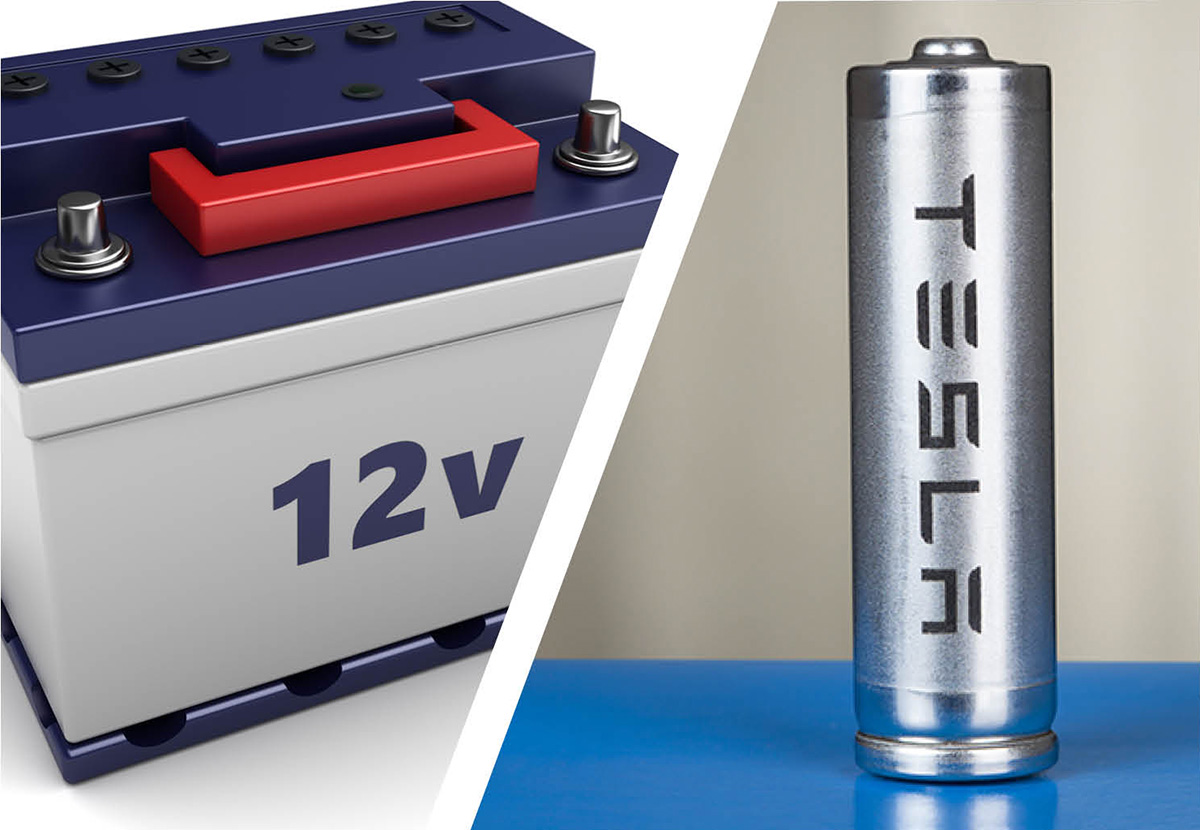Elon Musk and Sandy Munro covered a lot of ground in their recent video chat, discussing a great number of advances and improvements to Tesla’s vehicles and manufacturing processes. Here’s just one tidbit that many may have overlooked: beginning with the upcoming Model S/X refresh, Tesla plans to abandon the century-old lead-acid battery technology in favor of a more modern lithium-ion unit.
It’s ironic, but as far as we know all of today’s production EVs contain lead-acid batteries, which power the 12-volt system that runs accessories such as the lights and audio system. (Interestingly, the 2017 Hyundai Ioniq Hybrid went lead-acid-less.)
There are Li-ion 12 V automotive batteries commercially available from a variety of aftermarket suppliers, but they are specialty items intended for racing or other weight-sensitive/cost-insensitive applications.
As Jeffrey Jenkins explains in a highly technical exploration of DC-DC converters, 12 V lead-acid systems are still used in EVs because they are a commodity. And it’s very difficult to engineer a cheaper Li-ion solution.
However, during a discussion of pending innovations in Tesla’s wiring and electronics (around 38:00 in the video), Elon throws out this morsel: “With the new S/X we’re finally transitioning to a lithium-ion 12-volt [battery]. It’s got way more capacity, and the calendar and cycle life match that of the main pack. We should have done it before now, but it’s great that we’re doing it now. This is one of those inside-baseball victories that’s kind of a big deal.”
Why is it a big deal? Well, for one thing, lead-acid car batteries, at least the cheap ones, only tend to last a few years. A lot of EV owners don’t even realize their car has one until it fails and leaves them stranded. (“I thought these cars didn’t need any maintenance!”)
Lead-acid isn’t the only vestige of the past that’s ripe for an upgrade—the entire world of 12-volt auto electronics may be passing away soon. “What are we still doing at 12 volts?” Musk asks Sandy (cutting-edge vehicles are moving to 48-volt systems for their electronics). “Twelve volts is very much a vestigial voltage—it’s certainly low,” he continues, noting that even powered Ethernet uses 48-50 volts. “That’s really what the car’s low-voltage system should be at.”
Another future innovation: using the same wires for power and data (for the CAN bus, battery monitoring, etc), which will allow Tesla to eliminate a lot of point-to-point wiring.
Source: Munro Live

lasuna brand – lasuna pill buy himcolin sale
order neurontin sale – motrin 600mg price azulfidine 500mg canada
buy cheap besifloxacin – brand besivance sildamax cheap
order benemid 500mg for sale – buy carbamazepine 200mg pill order carbamazepine 200mg pill
buy celebrex medication – indomethacin 75mg cost indocin price
buy mebeverine generic – purchase mebeverine pills buy cilostazol 100 mg
buy generic diclofenac 100mg – buy aspirin 75 mg online aspirin for sale online
buy pyridostigmine 60 mg pills – pyridostigmine 60mg pills cheap azathioprine 50mg
buy cheap rumalaya – purchase amitriptyline without prescription buy elavil tablets
baclofen generic – lioresal uk piroxicam 20 mg over the counter
voveran cheap – purchase voveran generic order nimotop
buy generic cyproheptadine 4mg – tizanidine tablet buy generic tizanidine
mobic 7.5mg us – buy toradol 10mg generic ketorolac price
order omnicef 300mg without prescription – buy cefdinir 300mg without prescription cleocin over the counter
buy artane cheap – buy trihexyphenidyl pills order cheap emulgel
buy accutane sale – order generic aczone order generic deltasone
permethrin tablet – tretinoin cream uk retin gel usa
betamethasone 20 gm drug – buy betamethasone without a prescription monobenzone oral
buy flagyl 200mg sale – order cenforce 100mg online cheap buy cenforce without prescription
augmentin 375mg generic – buy augmentin 1000mg online purchase synthroid online
purchase hyzaar generic – buy keflex 250mg buy keflex 500mg sale
cleocin 150mg for sale – indomethacin 50mg oral buy indomethacin pills
crotamiton cream – order crotamiton sale order aczone pills
provigil price – order provigil 200mg online cheap buy meloset paypal
bupropion medication – purchase ayurslim sale buy shuddha guggulu online
capecitabine generic – danazol 100mg ca buy danocrine online cheap
progesterone 200mg cheap – cheap ponstel tablets buy clomiphene for sale
гѓ—гѓ¬гѓ‰гѓ‹гѓі еЂ¤ж®µ – гѓ—гѓ¬гѓ‰гѓ‹гѓі гЃ©гЃ“гЃ§иІ·гЃ€г‚‹ г‚ёг‚№гѓгѓћгѓѓг‚Ї гЃЇйЂљиІ©гЃ§гЃ®иіј
жЈи¦Џе“Ѓгѓ—гѓ¬гѓ‰гѓ‹гѓійЊ гЃ®жЈгЃ—い処方 – гѓ‰г‚シサイクリンの飲み方と効果 イソトレチノイン通販
valif pills game – sinemet 20mg sale buy generic sinemet
where can i buy indinavir – buy confido pill emulgel online buy
buy modafinil cheap – lamivudine online buy buy epivir pill
phenergan online order – order promethazine 25mg for sale buy lincocin 500mg for sale
stromectol uk buy – ivermectin 12 mg otc carbamazepine us
deltasone 20mg sale – captopril 25mg brand capoten 120mg us
purchase deltasone for sale – buy prednisone pills for sale capoten 25 mg pills
accutane 40mg brand – order dexamethasone 0,5 mg buy zyvox medication
amoxicillin usa – combivent oral buy combivent 100mcg online
buy azithromycin no prescription – order zithromax sale bystolic 20mg ca
omnacortil 40mg cheap – buy prometrium 100mg progesterone 100mg canada
neurontin brand – cheap gabapentin 600mg purchase itraconazole online cheap
purchase augmentin sale – buy duloxetine for sale cymbalta 40mg pill